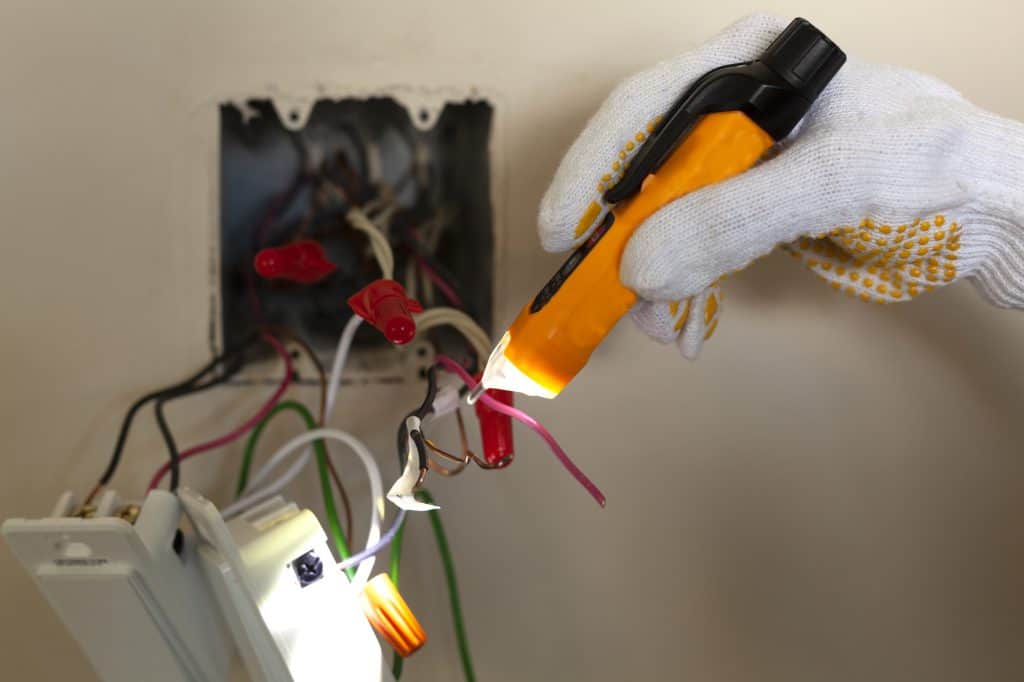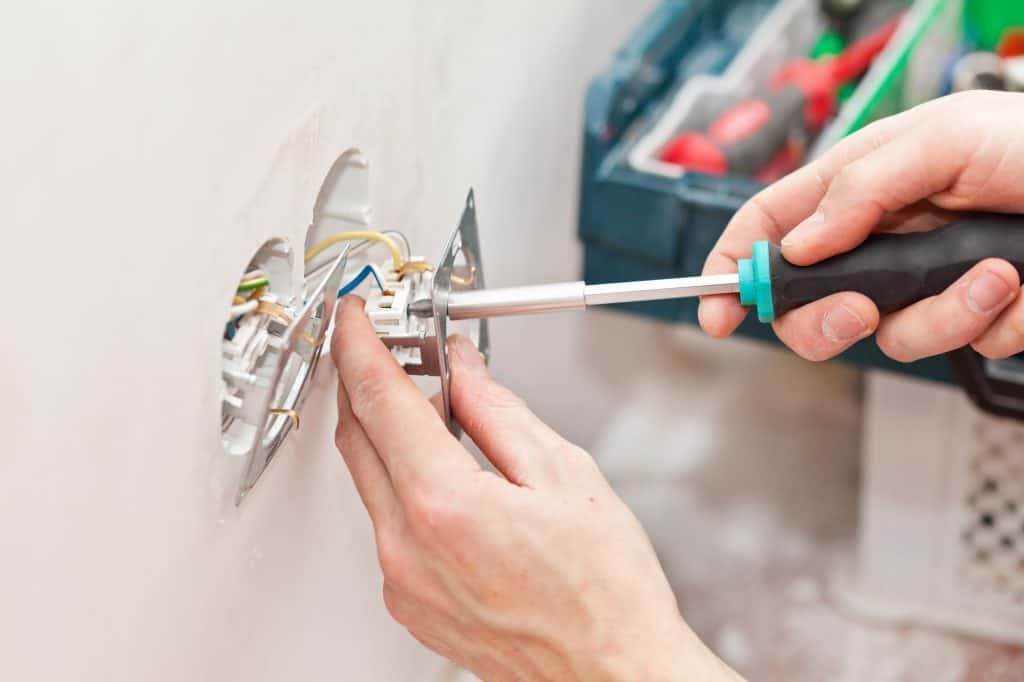Maybe in your electrical DIY projects, you have come across a situation where you find a bunch of wires have been twisted together and connected to one wire. If you have, this is a pigtail. Don’t worry, they won’t start squealing, and nor will the smell of sizzling bacon start coming from your outlet, but because it can look confusing, you may be asking yourself if these pigtails should be in there in the first place? Shouldn’t one wire go to one screw only?
If done correctly, a pigtail in an outlet is safe. The advantage of the pigtail method is that if an outlet has a fault, power will still flow to the rest of the circuit. With the alternative feed-through method, a fault in the device will stop the current from flowing to the rest of the circuit.
Just because it has this advantage, however, doesn’t mean you have to do it this way, or even that you should. If you can get to grips with why a pigtail is the best solution for your situation you can make the safest and most informed decision. Here’s some information to help you make the decision.
Reminder: Remember that your top priority, particularly when you are working with electrical equipment, has to be safety. This article has been fact-checked for accuracy, but every electrical installation is different. If you are in any doubt about what electrical work or modifications are required, you should seek advice from a qualified electrician.
What Is Pigtailing In A Circuit?
An electrical pigtail is a technique that is sometimes used by electricians to do one of the following:
- Lengthen wires that are too short to work with in an outlet box or other situation
- Combine multiple wires together that terminate in a receptacle and connect them to one conductor wire that is long enough to work with
- Create a connection to downstream appliances that will still work if that one has a fault
- Create space in a receptacle box because fewer screws need to be connected to wires
- Control two or more light fixtures which are fed by different cables leading from the switch box
- Reduce the number of earthing connections as pigtails combine multiple connections meaning fewer earthing connections are needed
Because there are a few good reasons to use a pigtail in an outlet box, it’s a very useful skill to have and is a must for anyone into DIY projects. This technique can save you time, and even make a more secure connection, and who doesn’t love to save time on a project?
It’s possible that this type of connection is called a pigtail because the exposed copper wires that are joined are twisted together and end up looking a little like the curly tail of a pig. Leave it to an electrician to ‘call it like I see it’!
Pigtailing throughout a project can also turn a potentially big headache into a smaller one: Because pigtailing makes a more secure connection by keeping the circuit flowing even if there is a fault, it can buy you some time to do a repair if one of the outlets in a circuit has a fault.
The other outlets in the circuit will still work making what could be a catastrophe of large parts of the circuit being down to an inconvenience of just one outlet or appliance acting up. This is useful for locations where there isn’t always someone on hand to make repairs or simply for peace of mind.
How Does Pigtailing Work?

A pigtail connection is a short length of wire that is connected to several circuit wires that are twisted together and sealed with an insulating wire nut (connector) at one end and then screwed to a screw terminal on an electrical device.
The National Electric Code (NEC) requires that a pigtail wire be at least 6 inches long. For safety, all pigtails must be sealed tightly with a wire nut!
Many electricians pigtail wires by connecting hot and neutral wires together that terminate in the same outlet. Once tests have been done to check that there is no power to the circuit, wires are grouped by color: white, black, and earth respectively, and then stripped of the protective coating. If an extension wire is being added, this is when it is put in.
All these wires are twisted together. (The good guys at anyhourservices.com give a handy tip to twist the wires clockwise because when you screw the wire nut on, you’ll most likely be twisting it in a clockwise motion, so twisting the wires clockwise beforehand ensures a tight electrical connection.) The single, loose wire can then be connected to the screw point on the device.
This means there is only one hot and one neutral connection screwed to the device even though many wires are coming in. This creates more room in the outlet box, and with less to squeeze into the box there is less chance of something coming loose because of crowding and pushing and less chance of terminals inadvertently touching something they shouldn’t.
It is always important to only pigtail white wires with white wires and black wires with black wires and also to keep the same gauge wires together. If you mix gauges and neutral/hot wires you will cause a short or a potential fire.
Is A Pigtail Allowed In An Electrical Outlet?
Provided the outlet and all parts are rated and UL-listed for feed-through wiring, the installation is properly done, and completely sealed with a wire nut or compliant wire connector, a pigtail in an outlet is safe and is allowed to be used.
There are no NEC regulations against pigtailing, except to detail that the pigtail should be a minimum of 6 inches. It is also a good practice to house pigtailed wires correctly, if it is not in an outlet box or some other housing the pigtail should be placed in a j-box or similar.
Even though pigtailing is allowed, there are a few things to keep in mind when working with wires in general. Take note of how many wires can be put where on the receptacle, the receptacle manufacturer should document how many wires can be used at different points. As a rule of thumb, if there are screws, attach only one wire per screw. When using the back-wire holes, only use one wire per hole. Also, ensure that the one wire is 14 gauge.
Is It Necessary To Pigtail Or Are There Better Alternatives?

The two options when dealing with wires are these:
- A feed-through connection. This is connecting the hot and neutral wires from the box to the receptacle or appliance and back into the box to feed the current back into the circuit through the receptacle.
- A pigtail connection. This is pigtailing the hot and neutral wires respectively from the box and connecting them with the single, pigtail wire each. Because this method moves the connection point from the receptacle to a wire nut, the current feeds back into the circuit independent of the receptacle or appliance.
Think of it this way:
A feed-through connection is like a road that must pass through a supermarket parking lot. During the day when the supermarket is open, this may work well enough, a car that is traveling to a destination beyond the supermarket can drive through the parking lot and be in its way. The flow works. If there is a problem in the parking lot, however, this will cause problems for any car trying to get beyond the supermarket.
A pigtail connection on the other hand is like an intersection at the entrance of the supermarket parking lot. There are many cars coming down different roads to the intersection, some may need to pass through the intersection to travel to a destination further down the road, and some may need to stop for groceries at the supermarket.
At the intersection, the cars choose which route to take – either to the supermarket or to carry on. When the supermarket parking lot is blocked or closed the traffic still flows because the intersection is independent of the parking lot. The pigtail connection has moved the intersection out of the parking lot.
Conclusion
When it is done correctly, a pigtail in an outlet is a safe and effective way of managing space in an outlet box. The pigtail method is often seen as a more secure connection because if there is a fault on the device power will still flow to the rest of the circuit.
The same is not always true when using the feed through method, a fault in the device will stop current flowing to the rest of the circuit. In this way, pigtailing may also save you time and headaches when needing to repair a fault.
Always keep a few things in mind when working with wires in general. Only pigtail when there is enough wire to do so safely, when using screws, attach only one wire per screw. Securely seal all pigtail connections with a wire nut and if in doubt, call an electrician!
Related Reading: Why Does A Specific Wall Outlet Keep Tripping The Breaker?
